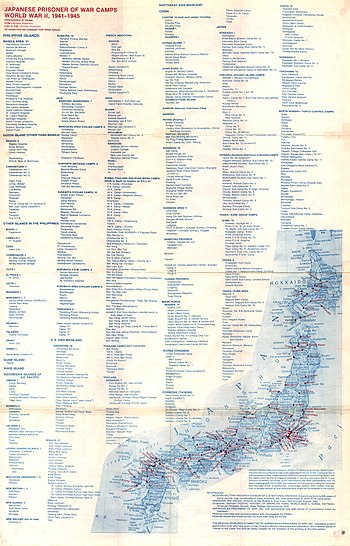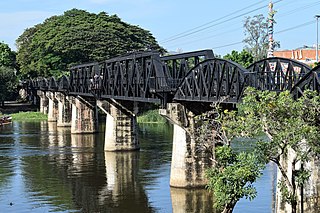
The Burma Railway, also known as the Siam–Burma Railway, Thai–Burma Railway and similar names, or as the Death Railway, is a 415 km (258 mi) railway between Ban Pong, Thailand, and Thanbyuzayat, Burma. It was built from 1940 to 1943 by South East Asian civilians abducted and forced to work by the Japanese and a smaller group of captured Allied soldiers, to supply troops and weapons in the Burma campaign of World War II. It completed the rail link between Bangkok, Thailand, and Rangoon, Burma. The name used by the Japanese Government was Tai–Men Rensetsu Tetsudō (泰緬連接鉄道), which means Thailand-Burma-Link-Railway.

The Kempeitai was the military police of the Imperial Japanese Army. The organization also shared civilian secret police, espionage, and counter-intelligence roles within Japan and its occupied territories, and was notorious for its brutality and role in suppressing dissent. The broad duties of the Kempeitai included maintaining military discipline, enforcing conscription laws, protecting vital military zones, and investigating crimes among soldiers. In occupied areas, it also issued travel permits, recruited labor, arrested resistance, requisitioned food and supplies, spread propaganda, and suppressed anti-Japanese sentiment. At its peak at the end of World War II, the Kempeitai was an extensive corps with about 35,000 personnel.

Ban Pong is a district (amphoe) of Ratchaburi province, Thailand. It is in the northeast of the province.
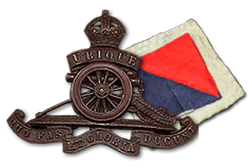
The 79th Light Anti-Aircraft Battery, also known as "The Sparrows", was a Royal Artillery unit of the British Army that fought in the Battle of Britain, the Battle of Java, and the Battle of Timor.

A hell ship is a ship with extremely inhumane living conditions or with a reputation for cruelty among the crew. It now generally refers to the ships used by the Imperial Japanese Navy and Imperial Japanese Army to transport Allied prisoners of war (POWs) and rōmusha out of the Philippines, the Dutch East Indies, Hong Kong and Singapore in World War II. These POWs were taken to the Japanese Islands, Formosa, Manchukuo, Korea, the Moluccas, Sumatra, Burma, or Siam to be used as forced labor.

Far East prisoners of war is a term used in the United Kingdom to describe former British and Commonwealth prisoners of war held in the Far East during the Second World War. The term is also used as the initialism FEPOW, or as the abbreviation Far East POWs.
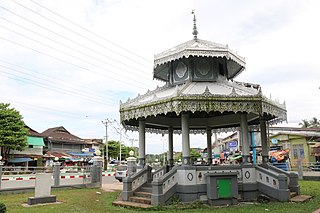
Thanbyuzayat is a town in the Mon State of south-eastern Myanmar. It is the administrative center for Thanbyuzayat Township. Thanbyuzayat is about 64 kilometres (40 mi) south of Mawlamyine (Moulmein) and 24 kilometres (15 mi) south-east of Kyaikkami (Amherst) and Setse beach.

Payathonzu is a town in the Karen State of south Myanmar, close to the border with Thailand. It is separated from the Thai border township of Nong Lu by the Three Pagodas Pass. It is also the administrative seat of Hpayarthonezu Sub-township in Kyain Seikgyi Township, Kawkareik District of Kayin State in Myanmar.
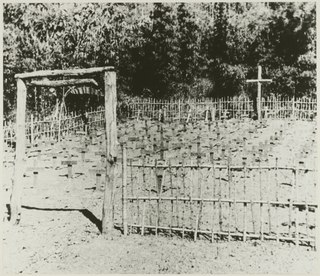
Apalon is a village alongside the Zami River in Kyain Seikgyi Township, Kawkareik District, Karen State, south-eastern Myanmar. The areas around Apalon are mountainous and forested. It is located on the Death Railway.
Kampong Makassar was one several internment camps in the island of Java near Batavia in which the Japanese interned enemy civilians, mostly Dutch, after the Dutch East Indies fell to Japanese forces in 1942. Between January and October 1945, Kampong Makassar functioned as prisoners of war, civilian, and relief camps respectively.
Tjideng was a Japanese internment camp for women and children during the Second World War, in then Batavia.
Kyauk Bi Lu or Kyaukbilu(Burmese: ကျောက်ဘီလူး) is a village tract of Kyain Seikgyi Township, Kawkareik District, in Kayin State, Myanmar (Burma). In 2014 it had a total population of 8,350 people. The village tract contains four villages.

Than Pu Yar or Thanbaya(Burmese: သံပုရာ) is a village tract of Kyain Seikgyi Township, Kawkareik District, in Kayin State, Myanmar (Burma). In 2014 it had a total population of 4,172 people. The village tract contains 2 villages.
Let Hpaw or Retpu is a village, village tract of Hlut Shan (Lutshan) in Kyain Seikgyi Township, Kawkareik District, Kayin State, Myanmar (Burma). It lies on the alongside of Thailand–Burma Railway.
Suzuya Maru was an auxiliary transport and hell ship of the Imperial Japanese Navy during World War II.

Chungkai War Cemetery, also known as Chung Kai War Cemetery, is a war cemetery in Tha Ma Kham near Kanchanaburi, Thailand. Established in the 1950s, the cemetery hosts the graves of 1,426 British and 313 Dutch prisoners of war who died during World War II. It was originally a prisoner of war camp on the Burma Railway.
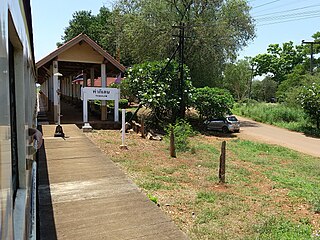
Tha Kilen railway station is a railway station located in Sing Subdistrict, Sai Yok District, Kanchanaburi Province. It is a class 2 railway station located 161.95 km (100.6 mi) from Bangkok railway station. It is located near the Mueang Sing Historical Park.

Franciscus Cornelis Gerardus "Fred" van der Poel was a Dutch military officer, and a football goalkeeper. He played one match for the Netherlands national football team in 1923. During World War II, he was taken prisoner of war by Japan and worked on the Burma Railway. He survived and fought in the Indonesian National Revolution on the Dutch side.

Camp Nong Pladuk was a Japanese prisoner of war transit camp during World War II. It was located about five kilometres from the main railway station of Ban Pong near a junction station on the Southern Line to Bangkok. Nong Pladuk served as the starting point of the Burma Railroad. Numerous British, Dutch, and allied troops passed through Nong Pladuk to construct the railroad. Nowadays, it serves as a rail road maintenance and repair facility.

Tha Khanun is a town and subdistrict (tambon) of Thong Pha Phum district of the Kanchanaburi Province, Thailand. It is named after the Jackfruit tree, and is located on the Khwae Noi River. Lam Khlong Ngu National Park and Wat Tha Khanun, a large Buddhist temple, are located near the town.

